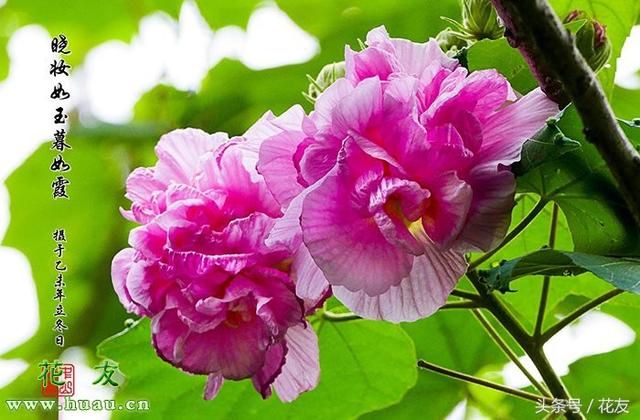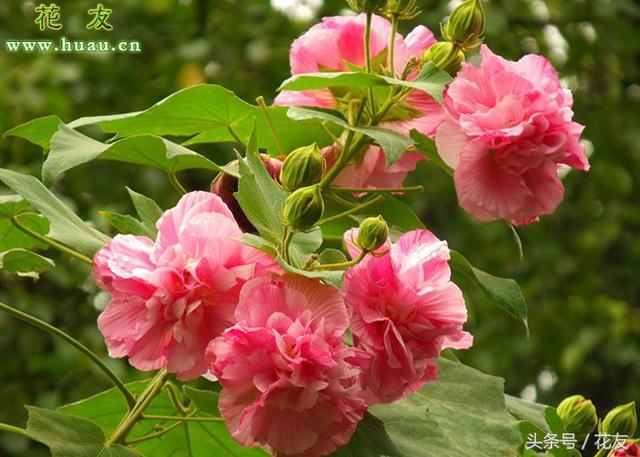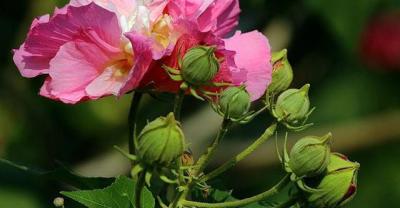The cultivation and maintenance of hibiscus is suitable for garden show horticulture.
Hibiscus, alias anti-frost flower, is closely related to hibiscus and Fusang, and is a deciduous shrub of the genus hibiscus of Malvaceae. Its flowers are shaped like peonies, blooming in frost, and are extremely beautiful.
China is the hometown of Hibiscus mulberry, which is distributed in other areas except Northeast and Northwest, especially in Hunan and Sichuan. People plant it on the bank of the pond and the waterfront to form the garden landscape of "hibiscus according to the water". In addition to being used as an ornamental, the flowers and leaves of Hibiscus hibiscus can be used as medicine, with the effects of clearing heat, detoxification, detumescence and so on.

Hibiscus hibiscus
Hibiscus can be divided into wild species and horticultural species, which can be divided into single and double flowers. Most of the wild species are single, and most of the cultivated species are double. Hibiscus flowers usually bloom in the twilight, white at the beginning of the morning, pink at noon, red in the afternoon, and closed and withered in the crimson. People describe them as "sunset makeup", which is called "drunken hibiscus". Hibiscus flowers are crimson at first, followed by white, goose yellow, pink, purple and so on. They can bloom for several days, change color day by day, and even appear different colors on a single flower. As each flower blooms first and later, there are often white, goose yellow, pink and other different colors of flowers on a hibiscus, which are dazzling.
Flower friends: the 10 most beautiful flowers
Hibiscus is a deep-rooted plant, the root is stout and slightly fleshy, like a warm, humid, sunny environment, but also drought-tolerant, slightly shade-tolerant. Its nature is extensive, the requirement of soil quality is not strict, and it grows best in loose, permeable and well drained sandy loam soil. Its cultivation should choose the place with good ventilation and fertile soil, especially adjacent to water.
The daily management of Hibiscus hibiscus is relatively extensive, watering should be paid attention to in drought, more fertilizer and water should be applied in spring sprouting period, and a small amount of phosphorus and potassium fertilizer should be applied before and after flowering. Ditches can be made around the plant every winter or spring and some mature organic fertilizer can be applied to make the plant grow exuberantly and bloom luxuriantly. When the flower bud is transparent, it should be properly watered to control its leaf growth and concentrate nutrients on the flower.

Hibiscus hibiscus
Hibiscus hibiscus has strong growth, strong sprouting ability, many and disorderly branches, so it should be pruned and sprouted in time. Hibiscus is resistant to pruning. It can be trimmed into trees or shrubs as needed. Pruning should be carried out after flowering and before sprouting in spring, and the withered branches, weak branches and inner branches should be cut off to ensure good ventilation and light transmission inside the crown. The shoots of plants planted in cold areas will freeze to death in winter, but more new shoots can sprout in the following spring. Therefore, it is best to cultivate its plant shape into a shrub.
Hibiscus potted plants should choose larger porcelain pots or plain roasted pots, which require loose and fertile soil, good drainage and air permeability, and sufficient moisture in the growing season. Winter moves to a room with a temperature of 0 ℃-5 ℃ to overwinter to ensure its full dormancy to facilitate flowering in the coming year.
Flower friends: living room plants and fengshui
The propagation of hibiscus hibiscus can be carried out by cutting, ramet or sowing. The best cuttage is from February to March. Choose moist sandy loam or clean river sand, and use 1-to 2-year-old strong branches with a length of 10 to 15 cm as cuttings. Soak the bottom of the cuttings in potassium permanganate solution with a concentration of 3 to 4 grams / liter for 15 to 30 minutes before cutting. The best depth of cuttage is 2 prime 3 of ear length. After planting, watering and plastic film mulching to keep the soil moist, it can take root in about 1 month and blossom in the coming year.

Hibiscus hibiscus
Ramet propagation should be carried out before sprouting in early spring, and the mother plants with exuberant tillers should be dug up and planted separately.
Sowing and propagation can collect fully mature hibiscus seeds after autumn and store them in a cool and ventilated place until the following spring. The seeds of Hibiscus hibiscus are small and can be mixed with fine sand and sown.
The soil of the seedbed should be fine, cover the soil, sprinkle water and keep the seedbed moist after sowing. Generally, seedlings can emerge after 25-30 days, and can only be transplanted in the following spring. In addition to timely spraying control, the plants should also be irrigated in time and thinned as necessary.
Friends who are interested in growing flowers can pay attention to: flower friends, there are wonderful flowers and beautiful articles to share with you every day, and fellow flower friends share the sea of flowers with you. Contribution email: huaucn [email protected].
- Prev

Control techniques of common diseases and insect pests in horticultural flowers
1 common diseases of horticultural flowers and their control techniques 1.1 Rhizoctonia solani infection in growing flowers will lead to root festering.
- Next

Rainforest vats, the next hot spot in the home gardening market?
In recent years, as the flower industry gradually turns to the home horticulture market, more and more flower products suitable for entering the family are emerging, from potted plants to green walls.
Related
- Wuhan Hospital Iron Tree Blooming Result Was Instantly Frightened by the Gardener Master
- Which variety of camellia is the most fragrant and best? Which one do you like best?
- What is the small blue coat, the breeding methods and matters needing attention of the succulent plant
- Dormancy time and maintenance management of succulent plants during dormancy
- Minas succulent how to raise, Minas succulent plant pictures
- What are the varieties of winter succulent plants
- How to raise succulent plants in twelve rolls? let's take a look at some experience of breeding twelve rolls.
- Attention should be paid to water control for succulent plants during dormant period (winter and summer)
- Watering experience of twelve rolls of succulent plants
- Techniques for fertilizing succulent plants. An article will let you know how to fertilize succulent plants.

